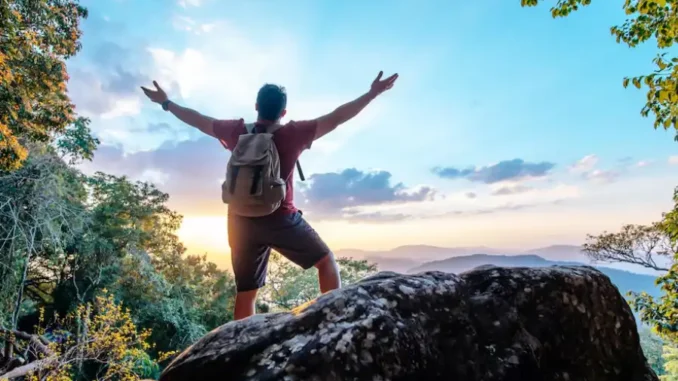
Physical health can be achieved, improved and maintained through different types of workouts or different physical activities. Everyone has their preferences but despite this, there are some that are really good for everyone. An example of this is hiking .
Useful for various physical and mental factors, it can be practiced by adults and children, and it can be done with different levels of commitment and duration so as to be suited to one’s abilities, desire and determination.
Let’s see below some of the advantages brought by this activity and why it can be a winning solution for those who love movement
Top 10 Benefits of Hiking
There are many activities that bring many benefits to our body and mind, but few have the advantages of hiking. Here are some reasons why it might become your new favorite workout.
- Helps you get back into shape
Looking for a way to stay active that doesn’t involve going to the gym all the time? Hiking might just be for you. Whether you’re hiking up fairly steep hills or trekking along a mountain trail, you’ll burn unwanted calories without even realizing it. All in all, hiking for two to three hours is a workout that can really help you feel fitter. - It’s a personalized workout
Each time you hike, you can choose your difficulty level, from beginner to advanced. You can decide the distance you will travel and the pace at which you will walk. Basically it’s your excursion, you follow your rules. This makes it a great physical activity, even for complete beginners. - Lowers Blood Pressure
Walking is a fantastic way to reduce blood pressure and cholesterol levels. Even more so, the effort generated by an intense activity such as a prolonged excursion will be able to keep your heart healthy and reduce the risk of cardiovascular disease. It also improves blood sugar levels which helps control and prevent diabetes. - Builds Muscle
Hiking engages all of your muscle groups, but it’s especially good for building lower limb strength. Walking steadily and on training inclines can shape your glutes, quadriceps and hamstrings. - Strengthen your core
All walking on uneven terrain requires you to constantly engage the core area of the body, which indirectly involves the activity of the abdominal muscles. - Maintains bone density
As we age, our bone density can decrease significantly, especially in women after menopause. To help maintain healthy bones, it is essential to get enough calcium and vitamin D through your diet and exercise. Hiking certainly helps to obtain the last two elements mentioned, since walking exposed to sunlight also allows our body to synthesize vitamin D. It therefore appears to be a beneficial exercise also from this point of view. - Union with nature
Are you one of those people who always works sitting indoors in the office? Hiking in open spaces allows you to unplug from the world for a moment and take a break from your routine. It takes you out of the house, allowing you to reconnect with yourself and nature. - Boost your brain
A walk in the mountains is not only good for maintaining the health of the body, but it is also great for the brain. Studies show that people who spend more time in nature are much more creative and responsive when it comes to making decisions. This is because being in nature increases your attention and concentration capacity. Researchers at Stanford University also found that walking makes you more creative than sitting. - Less stress
Various studies relating to physical activity indicate how movement is useful in reducing mental stress and anxiety, often accumulated during our days. Nature is also an excellent ally in obtaining these results, so it is easy to understand how a combination of physical activity and the natural environment can be extremely beneficial for our mood and to relax our mind. - Socialize
Sport generally has a great capacity for aggregation and allows you to meet new people and develop new social relationships. An excursion or organized trip in the mountains or in the open air creates new encounters and above all great possibilities for acquaintances during the activity itself, being long-lasting and easy to carry out in a group. In addition to this, moving in company can also be more motivating in the long term and this allows you to consistently benefit from the physical improvements induced by this activity.

Generally during trekking activities it is useful to have strategies that allow you to have an experience free of misadventures. We could include the best tips for beginners in the following list:
- Comfort first and foremost: wearing comfortable clothes that allow you to move around easily and suitable shoes that protect your ankles are certainly among the priorities;
- Stay hydrated: it is important to drink plenty of water during excursions as well as during classic, intense physical activity. Don’t forget to always carry your water bottle with you;
- Easy to carry foods: nuts, dried fruit or bars, to eat when necessary to replenish your energy;
- Bring only what you need: if you have a backpack with you, make sure it is light and don’t overload the bag with unnecessary items. It will tire you more and make your business more stressful;
- Last, but not least, safety: Remember, the hike is supposed to be a fun time, so act safely. Prepare a route that is suited to your current physical abilities and check the weather conditions before venturing into natural environments.
A chance to get some fresh air, a full-body workout, and a mood and stress boost all at the same time, it doesn’t get much better than hiking when it comes to beneficial exercise.